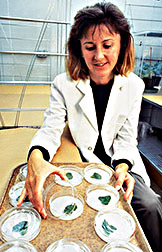Science Update
|
|
Gene That Boosts Plant Hormone Is Patented
ARS has received a patent on a modified gene that lets plants put up a stronger, faster defense when insects are eating them. The agency seeks an industry partner for a cooperative research and development agreement (CRADA), so that farmers may eventually benefit. Tomato and tobacco plants with the modified gene churn out large amounts of cytokinin, a multipurpose plant hormone. In the typical geneengineering approach, an inserted gene makes plants produce lots of caterpillar-killing proteins, and they make these proteins nearly all the time. The cytokinin tactic may more closely simulate plants' natural defense response. With the modified cytokinin gene, plants make extra amounts of the hormone only when being chewed on or otherwise wounded. That's because an ARS researcher gave the gene a new "on" switch, a wound-inducible promoter from potatoes. In tests, 60 to 70 percent of green peach aphids failed to survive a diet of leaves from the transformed plants. Tomato hornworms lived, but they ate 60 percent less than normal. The researcher is trying to purify insect-killing compounds made by the plants. She and cooperators are also trying to put the gene to work in sugar beets, soybeans, strawberries, and other plants.
Ann C. Smigocki, USDA-ARS Plant Molecular Biology Laboratory, Beltsville, Maryland, phone (301) 504-7118.
Second Test Needed To Spot Elevated Amino Acid
Earlier research linked high blood levels of an amino acid, homocysteine, to increased risk of heart disease and stroke. It's crucial, then, for homocysteine tests to be as reliable as possible. The standard test is to measure a person's homocysteine level after an overnight fast. Using only this test, however, could miss nearly half of the people with elevated homocysteine levels. That finding comes from a recent ARS study with about 270 volunteers. The scientists showed that identifying all cases of elevated homocysteine requires a second measurement—obtained a few hours after a dose of a different amino acid, methionine. Three vitamins—folate (folic acid), B12, and B6—play roles in metabolizing homocysteine, explain the researchers. But inadequate B6, they add, is caught only by the test given after the methionine dose.
Jacob Selhub, USDA ARS Jean Mayer USDA Human Nutrition Research Center on Aging at Tufts, Boston, MA; phone: (617) 556-3191.
First Cotton Harvested Is Not First Choice of Whitefly
The first bale of cotton harvested in the United States last year (on June 14) was a new commercial variety bred from ARS-developed germplasm. The new cotton offers some natural protection against silverleaf whiteflies, voracious pests of cotton and many other crops. Cotton growers need every possible edge to reduce the pests' feeding and other damage. The ARS germplasm line—like its commercial offspring, the new Texas 121 variety—matures a week earlier than most cotton varieties. This lets the crop partially escape the late-season whitefly buildup in south Texas. The new plants' other characteristics, such as smooth leaves, make them less attractive to whiteflies looking to feed and lay eggs. For producing hybrid cottonseed, ARS released different germplasm lines with the anti-whitefly traits.
"Science Update" was published in the May 1996 issue of Agricultural Research magazine.







